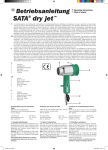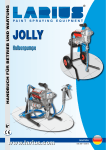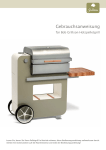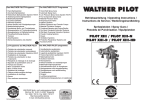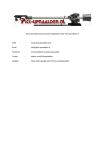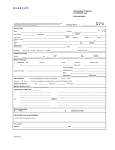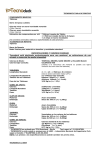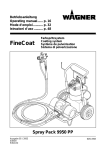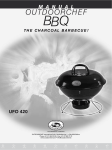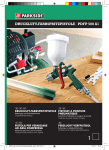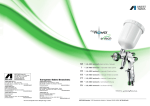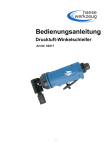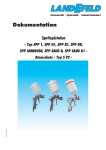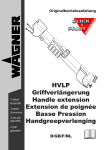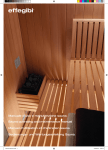Download SATAgraph™ 1 - Coast Industrial Systems, Inc.
Transcript
SATAgraph™ 1 Betriebsanleitung - Operating instructions Instrucciones de servicio 4 3 2 10 1 7 5 3a 6 7 8 9 Betriebsanleitung SATAgraph 1 Vorwort deutsch Vor Inbetriebnahme des Gerätes/der Lackierpistole ist die Betriebsanleitung vollständig und eingehend zu lesen, beachten und einzuhalten. Danach ist diese an einem sicheren Platz, für jeden Gerätebenutzer zugänglich, aufzubewahren. Das Gerät/die Lackierpistole darf nur von sachkundigen Personen in Betrieb genommen werden. Bei unsachgemäßer Benutzung des Gerätes/der Lackierpistole oder jeglicher Veränderung oder Kombination mit ungeeigneten Fremdteilen können Sachschäden, ernste Gesundheitsschäden der eigenen Person, von fremden Personen und Tieren bis hin zum Tode die Folge sein. SATA übernimmt für diese Schäden (z.B. Nichteinhaltung der Betriebsanleitung) keinerlei Haftung. Die anwendbaren Sicherheitsvorschriften, Arbeitsplatzbestimmungen und Arbeitsschutzvorschriften des jeweiligen Landes oder Verwendungsgebietes des Gerätes/der Lackierpistole sind zu beachten und einzuhalten (z. B. die deutschen Unfallverhütungsvorschriften BGR 500 (BGV D25) und BGV D24 des Hauptverbandes der gewerblichen Berufsgenossenschaften usw.). Zu beachten Lackierpistole nie auf sich selbst, fremde Personen oder Tiere richten. Löse- und Verdünnungsmittel können zu Verätzungen führen. Nur die zum Arbeitsfortschritt notwendige Lösemittel- und Lackmenge darf in der Arbeitsumgebung des Gerätes vorhanden sein (nach Arbeitsende sind Lösemittel und Lacke in bestimmungsgemäße Lagerräume zurückzubringen). Vor jeglichen Reparaturarbeiten muß das Gerät vom Luftnetz abgekuppelt werden. Vor jeder Inbetriebnahme, besonders nach jeder Reinigung und nach Reparaturarbeiten, ist der feste Sitz aller Schrauben und Muttern sowie die Dichtheit der Pistolen und Schläuche zu überprüfen. Defekte Teile sind auszutauschen oder entsprechend instandzusetzen. Zur Erzielung bestmöglicher Lackierergebnisse und für höchste Sicherheit nur Original-Ersatzteile verwenden. Beim Lackieren darf im Arbeitsbereich keine Zündquelle (z.B. offenes Feuer, brennende Zigaretten, nicht explosionsgeschützte Lampen usw.) vorhanden sein, da beim Lackieren leicht entzündliche Gemische entstehen. Beim Lackieren ist den Vorschriften entsprechender Arbeitsschutz zu verwenden (Atemschutz usw.). Bei Anwendung der Lackierpistole werden keine Vibrationen auf Körperteile des Bedieners übertragen. Die Rückstoßkräfte sind gering. Der Einsatz dieses Produktes in explosionsgefährdeten Bereichen der Zone 0 ist verboten. SATA, das SATA-Logo und/oder andere hier im Inhalt erwähnte SATA-Produkte sind entweder registrierte Warenzeichen oder Warenzeichen der SATA GmbH & Co. KG in den USA und/oder anderen Ländern. 1. Lieferausführung und technische Daten 1.1. Fließbecherausführung • Pistole mit Düse 0,25 • 2,5 ml Fließbecher mit Deckel • Gewicht: ca 94 g • Arbeitsdruck zwischen 1,0 bis 3,0 bar (14 bis 43 psi) • Empfohlener Pistoleneingangsdruck 2,5 bar (35 psi) • Max. Pistoleneingangsdruck 4 bar (58 psi) I.1 Betriebsanleitung SATAgraph 1 1.2. Hängebecherausführung • Pistole mit Düse 0,25 (0,45) • 5 ml Hängebecher mit Deckel • Gewicht: ca. 100 g • Pistoleneingangsdruck zwischen 1,0 und 3,0 bar (14 und 43 psi) • Empfohlener Pistoleneingangsdruck 2,5 bar (35 psi) • Max. Pistoleneingangsdruck 4 bar (58 psi) 2. Funktionsbeschreibung Bei der SATAgraph 1 handelt es sich um eine „Double-Action“ Airbrush-Lackierpistole bei der die Druckluft- und Materialmenge unabhängig von einander gesteuert und dosiert werden kann. Durch Drücken auf den Abzugshebel (1) wird die Druckluft freigegeben und die Druckluftmenge geregelt. Beim Zurückziehen des Abzugshebels (1) wird die Nadel aus der Farbdüse herausgezogen und der Materialfluß freigegeben. Die Dosierung erfolgt über den Abzugsweg in Abhängigkeit der Voreinstellung der Farbnadel (6) - siehe Kapitel 4.5. Verschiedene Effekte können durch Varianten von Luft- und Lackmenge in weiten Grenzen varriert werden. 1 Der Abzugshebel wird gedrückt und gleichzeitig nach hinten gezogen. Dadurch wird die Nadel nach hinten gedrückt und gibt die Düsenöffnung für die Farbzufuhr frei. 1 2 2 Durch das Herunterdrücken des Abzugshebels wird das Luftventil geöffnet. Druckluft strömt durch die Düse und reißt durch den entstehenden Unterdruck die Farbe mit. Farbzufluß Druckluft Hebelmechanik Bitte beachten: Den Abzugshebel während des gesamten Spritzvorganges auf Druck halten. Es gilt die Regel: „Mit Druckluft anfangen, mit Druckluft aufhören“! 3. Aufbau 1 Abzugshebel 2 Pistolenkörper 3 (a) Fließbecher/Hängebecher 4 Luftdüse 5 Farbdüse (nicht sichtbar) I.2 6 7 8 9 10 Farbnadel (nicht sichtbar) Luftkolbeneinheit (nicht sichtbar) Luftanschluß Farbnadelschnellspannung (nicht sichtbar) Endstück Betriebsanleitung SATAgraph 1 4. Inbetriebnahme deutsch Vor jeder Inbetriebnahme, besonders nach jeder Reinigung und nach Reparaturarbeiten, ist der feste Sitz aller Schrauben, Muttern und Verschraubungen zu überprüfen.Bei Wartungs- und Reparaturarbeiten jeglicher Art muss das Gerät in drucklosem Zustand sein, d.h. vom Luftnetz abgekuppelt werden und frei von Lacken und Farben sein. Die Lackierpistole wurde vor dem Versand mit Korrosionsschutzmittel behandelt und sollte daher vor dem Gebrauch mit Verdünnung oder Reinigungsmittel durchgespült werden. Nichtbeachtung dieses Sicherheitshinweises kann zu Beschädigungen und Verletzungen, bis hin zum Tode, führen. SATA übernimmt keine Haftung für eventuelle Folgen der Nichtbeachtung. 4.1 Luftdruck Der Arbeitsdruck liegt bei ca. 1 - 3 bar. Je höher der Pistoleneingangsdruck um so besser ist die Zerstäubung, desto schwieriger das Handling. Bei zu geringem Druck wird in Abhängigkeit des Lackmaterials keine optimale Farbzerstäubung erzielt. Bei einem Kompressor mit Reguliermöglichkeiten des Abgangsdruckes, kann mit unterschiedlichen Drücken experimentiert werden, bis die gewünschten Ergebnisse erzielbar sind. 4.2 Lackmaterial Bei Verwendung von lösemittelhaltigen Farben und Lacken ist darauf zu achten, dass diese soweit verdünnt werden bis sie eine Konsistenz von Milch aufweisen. Andernfalls sind die Farben und Lacke zu dick zum Brushen und es ist keine feine Zerstäubung bei ausreichendem Materialfluss erzielbar. Auch wasserverdünnbare Farben und Lacke müssen ausreichend verdünnt werden. Moderne Airbrushfarben und Lacke werden schon spritzfertig angeboten. Bitte beachten sie die Angaben der Hersteller. 4.3 Richtige Einstellung des Pistoleneingangsfließdruckes Gewünschten Arbeitsdruck (1 - 3 bar) an der Druckregeleinheit des Kompressors einstellen, soweit vorhanden. Diese ist direkt am Luftabgang des Kompressors oder in eine Luftversorgungsleitung eingebaut. Der Druckregler kann auch eine zwischengeschaltete Druckluftfiltereinheit mit Druckminderer z. B. „SATA 0/444“ sein. Durch das Niederdrücken des Abzugshebels (1) kann die Druckluftmenge gesteuert werden. 4.4 Materialmenge Durch ziehen des Abzugshebels (1) kann die Materialmenge gesteuert werden. Einstellen des benutzerdefinierten Nadelabhubs: Endstück (10) abschrauben, Farbnadelschnellspannung (9) lösen. Den Anschlag für den Abzugshebel (1) nach Bedarf einstellen (auf Position halten), Farbnadel unter leichtem Druck nach vorne in die Farbdüse (5) auf Anschlag schieben und danach Farbnadel mit Hilfe der Farbnadelspannung (9) fixieren. Endstück (10) anschrauben. + - + I.3 Betriebsanleitung SATAgraph 1 4.5 Düsensatzwechsel (ohne Werkzeug) Der Düsensatz besteht aus der Luftdüse (4), Farbdüse mit O-Ring (5) und Farbnadel (6). Zur Demontage des Düsensatzes, muss das Endstück (10) komplett vom Pistolenkörper (2) abgeschraubt werden. 10 Nach dem Lösen der Farbnadelschnellspannung (9) kann die Farbnadel (6) nach hinten aus dem Pistolenkörper (2) herausgezogen werden. 2 96 Entnahme der Farbdüse (5) aus dem Pistolenkörper (2) nach Abschrauben der Luftdüse (4). Bitte Beachten: Die Farbdüse (5) ist nur lose in die Luftdüse (4) eingelegt, so dass diese herunterfallen und beschädigt werden könnte. Montage in umgekehrter Reihenfolge: Nach dem Festziehen der Luftdüse (4) wird die Farbnadel (6) vorsichtig bis zum Anschlag nach vorne hin zur Farbdüse (5) in den Pistolenkörper (2) eingeschoben und durch anziehen der Farbnadelschnellspannung (9) fixiert. Farbdüse (5) nicht verkanten und Farbnadelspitze nicht beschädigen. Achtung: Verletzungsgefahr an der Nadelspitze. Bei Einbau von Fremdteilen ist Qualitätsminderung möglich und die SATA-Garantie erlischt. 4 5 Düsensätze: 134619 0,25 für SATAgraph 1 (1 Kerbe auf Farbnadel, Farb-/Luftdüse) 134635 0,45 für SATAgraph 1 (3 Kerben auf Farbnadel, Farb-/Luftdüse) 5. Reinigung und Wartung Bitte wenden Sie niemals Gewalt an. Große Rohrzangen, Schweißbrenner usw. sind ungeeignete Hilfsmittel. Eine sachgemäße Reparatur kann in vielen Fällen nur mit Spezialwerkzeugen durchgeführt werden. Beschränken Sie sich in diesem Fall auf die Feststellung der Schadensursache und überlassen Sie die Behebung unserem Kundendienst. Nach einer Selbstdemontage erlischt die Haftung für das einwandfreie Funktionieren der Pistole. a) Airbrush-Lackierpistole bei jedem Farbwechsel reinigen. b) Lackierpistole mit Wasser, Airbrushreiniger oder mit entsprechendem Lösungsmittel spülen. Bei sehr pigmenthaltigen Farben und Lacken sammeln sich schnell Farb- und Lackreste sowohl auf der Nadel als auch im Bereich der Nadelkappe an. c) Nach Abschluss der Arbeit ist eine gründliche Reinigung der mit Lack und Farbe kontaktierten Teilen erforderlich. d) Die eingebaute Luftkolbeneinheit (7) sollte nach Möglichkeit nicht zerlegt werden. Gelegentlich Hebelmechanik und Nadel im Bereich der Hebelmechanik dünn mit silikonfreiem Pistolenfett (Best.-Nr. 48173) einfetten. I.4 Nadelspitze und den Bereich der Luft- und Farbdüse nicht fetten! Betriebsanleitung SATAgraph 1 deutsch Wichtiger Hinweis: Pistole kann mit Löse- oder Reinigungsmitteln von Hand oder in einer konventionellen Pistolenwaschmaschine gereinigt werden. Folgende Maßnahmen beschädigen die Pistole/Einrichtungen und können ggf. zum Verlust des Explosionsschutzes und zum völligen Verlust von Gewährleistungsansprüchen führen: - Einlegen der Pistole in Löse- oder Reinigungsmittel länger als für die Reinigung selbst erforderlich - Nichtentnehmen der Pistole aus der Pistolenwaschmaschine nach Beendigung des Waschprogramms - Reinigen der Pistole in Ultraschallreinigungssystemen 6. Mögliche Funktionsstörungen Störung Ursache Abhilfe 1. Pistole tropft Fremdkörper zwischen Farbnadel und Farbdüse verhindert Abdichtung Farbnadel und Farbdüse ausbauen, reinigen oder neuen Düsensatz einsetzen. Einstellung der Farbnadel korrigieren. 2. Spritzbild ist schlecht Verschmutzung oder Abnutzung der Teile Farbdüse, Farbnadel oder Luft-düse reinigen. Teile ersetzen 3. Strahl flattert - Nicht genügend Material im Behälter - Farbdüse nicht angezogen - Material nachfüllen 4. Material sprudelt oder „kocht“ im Farbbecher Leckage an der Düsendichtung - Dichtfläche an Dichtung und Körper reinigen - Luftdüse etwas fester ziehen - Teile ersetzen - Teile entsprechend anziehen 7. Ersatzteile (siehe Ersatzteilzeichnung am Ende des Heftes) Pos. Nr. ID.-Nr. 1 134809 3 134767 134775 9 32615 11 134825 32987 134791 134841 • 138909 * Benennung Düsensatz SATAgraph 1 Abzugshebel Fließbecher 2.5 ml mit Deckel Fließbecher 5 ml mit Deckel Packung mit 3 Kupplungsnippeln und Dichtungen Endstück PVC-Schlauch, kpl. 3 m Gewebeschlauch, kpl. 2.5 m Reparatur-Set SATAgraph 1 O-Ring Set für Farbdüse (5 St.) I.5 Betriebsanleitung SATAgraph 1 8. Garantiebedingungen Für Lackierpistolen leisten wir eine Garantie von 12 Monaten, die mit dem Tage des Verkaufs an den Endabnehmer beginnt. Die Garantie erstreckt sich auf den Materialwert von Teilen mit Fabrikationsund Materialfehlern, die sich innerhalb der Garantiezeit herausstellen. Ausgeschlossen sind Schäden, die durch ungeeignete oder unsachgemäße Verwendung, fehlerhafte Montage bzw. Inbetriebsetzung durch den Käufer oder durch Dritte, natürliche Abnutzung, fehlerhafte Behandlung oder Wartung, ungeeignete Spritzmaterialien, Austauschwerkstoffe und chemische Einflüsse wie Laugen und Säuren, elektrochemische oder elektrische Einflüsse entstehen, sofern die Schäden nicht auf ein Verschulden von uns zurückzuführen sind. Schmirgelnde Spritzmaterialien, wie z.B. Bleimennige, Dispersionen, Glasuren, flüssige Schmirgel o.ä. verringern die Lebensdauer von Ventilen, Packungen, Pistole und Düse. Hierauf zurückzuführende Verschleißerscheinungen sind durch diese Garantie nicht gedeckt. Das Gerät ist unverzüglich nach Empfang zu kontrollieren. Offensichtliche Mängel sind innerhalb von 14 Tagen nach Empfang des Gerätes der Lieferfirma oder uns schriftlich mitzuteilen, andernfalls erlischt das Recht auf Garantieleistungen. Weitergehende Ansprüche jeglicher Art, insbesondere auf Schadenersatz, sind ausgeschlossen. Das gilt auch für Schäden, die bei Beratung, Einarbeitung und Vorführung entstehen. Wünscht der Käufer sofortige Reparatur oder Ersatz, bevor festgestellt ist, ob von uns eine Ersatzpflicht besteht, so erfolgt die Ersatzlieferung oder Reparatur gegen Berechnung und Bezahlung des jeweiligen Tagespreises. Stellt sich bei der Überprüfung der Mängelrüge heraus, daß ein Garantieanspruch besteht, erhält der Käufer für die berechnete Reparatur oder Ersatzlieferung eine Gutschrift entsprechend der Garantieleistung. Teile, für die Ersatz geliefert wurde, gehen in unser Eigentum über. Mängelrügen oder sonstige Beanstandungen berechtigen den Käufer bzw. Auftraggeber nicht, die Bezahlung zu verweigern oder zu verzögern. Versand des Gerätes hat an uns spesenfrei zu erfolgen. Montagekosten (Arbeitszeit- und Fahrtkosten) sowie Fracht- und Verpackungsspesen können wir nicht übernehmen. Hier gelten unsere Montagebedingungen. Garantieleistungen bewirken keine Verlängerung der Garantiezeit. Die Garantie erlischt bei Fremdeingriffen. Achtung! Bei Verwendung von Löse- und Reinigungsmitteln auf der Basis halogenisierter Kohlenwasserstoffe. wie z.B. 1,1,1-Trichloräthan und Methylen-Chlorid, können an Aluminiumbecher, Pistole sowie galvanisierten Teilen chemische Reaktionen auftreten (1,1,1Trichloräthan mit geringen Mengen Wasser ergibt Salzsäure). Die Teile können dadurch oxydieren, im extremen Fall kann die Reaktion explosionsartig erfolgen. Verwenden Sie deshalb für Ihre Farbspritzgeräte nur Löse- und Reinigunsmittel, die die obengenannten Bestandteile nicht enthalten. Zur Reinigung auf keinen Fall Säure, Lauge (Basen, Abbeizer etc.) verwenden. 9. EU-Konformitätserklärung Die Lackierpistolen der Firma SATA sind entwickelt, konstruiert und gefertigt in Übereinstimmung mit der EG-Richtlinie 98/37/EG, 94/9/EG. Es wurden dabei folgende harmonisierte Normen angewandt: DIN EN 292, Sicherheit von Maschinen, Geräten und Anlagen, DIN EN 1953, DIN 31000, DIN 31001 Teil 1, BGR 500 (BGV D25), BGV D24 und bei Bedarf die ZH 1/406, ZH 1/375 und ZH 1/181. Die technische Dokumentation ist vollständig vorhanden und die zur Lackierpistole gehörende Betriebsanleitung liegt in der Originalfassung sowie in der Landessprache des Anwenders vor. SATA GmbH & Co. KG Geschäftsführer I.6 Operating Instructions SATAgraph 1 Preface english Prior to putting the unit/paint spray gun into operation, read the operating instructions completely and thoroughly. The stipulations contained therein are to be respected in any case. After that, the operating instructions are to be stored in a safe place, accessible for every user of the equipment. The unit/paint spray gun may only be put into operation by persons familiar with its use. Inappropriate use of the unit/paint spray gun, modification of any kind or combination with inappropriate other parts may cause material damage, serious hazard to the user‘s, other person‘s or animal‘s health or even death. SATA shall not take any responsibility for such damages (e.g. failure to respect the stipulations laid out in the operating instructions). The applicable safety, workplace and worker health protection regulations of the respective country or area/district in which the system/the paint spray gun is used are to be respected in any case (e.g. the German Rules for the Prevention of Accidents BGR 500 (BGV D25) and BGV D24 issued by the Central Office of the Professional Trade Associations, etc.). To be noted Never point paint spray guns at yourself, at other persons or animals. Solvents and thinners can cause burns. Only the respective quantities of solvents and paints required for work progress may be present in the direct surroundings of the unit (after work, solvents and paints are to be returned to their assigned storage rooms). Prior to any repair work the unit must be disconnected from the air supply. Prior to putting the unit into operation, especially after each cleaning and each repair work, check all screws and nuts for tight fit, as well as the sealing performance of the spray guns and hoses. Defective components must be replaced or repaired accordingly. To obtain best possible coating results, and for maximum safety, only use original spare parts. No sources of ignition (e.g. open flames, burning cigarettes, lamps without ex-protection etc.) may be present during painting, as easily flammable mixture are generated during the painting process. Occupational safety regulations must be applied when painting (respiratory protection, etc.). No vibration is transmitted to the upper parts of the operator‘s body during use of the paint spray gun. Recoil forces are negligible. The use of this product in explosion hazard areas Zone 0 is prohibited. SATA, the SATA Logo and/or other SATA products referenced herein are either registered trademarks or trademarks of SATA GmbH & Co. KG in the U.S. and/or other countries. The names of companies and products mentioned herein may be the trademarks of their respective owners. 1. Features and technical data 1.1. Gravity flow cup version • Gun with nozzle 0.25 • 2.5 ml gravity flow cup with lid • Replacement “O“ ring for paint nozzle • Weight: approx. 94 g • Operating pressure between 1.0 and 3.0 bars (14 to 43 psi) • Recommanded un inlet pressure 2.5 bars (35 psi) • Max. gun inlet pressure 4 bars (58 psi) II.1 Operating Instructions SATAgraph 1 1.2. Siphon cup version • Gun with nozzle 0.25 (0,45) • 5 ml siphon cup with lid • Weight: approx. 100 g • Operating pressure between 1.0 and 3.0 bars (14 to 43 psi) • Recommanded un inlet pressure 2.5 bars (35 psi) • Max. gun inlet pressure 4 bars (58 psi) 2. Functional Description The SATAgraph 1 is a „Double Action“ airbrush paint spray gun allowing to control and to dose compressed air supply and material flow independently from each other. By pushing the trigger (1) the compressed air is released, and the compressed air volume is regulated. When pulling back the trigger (1), the needle is pulled out of the paint nozzle, and material flow is released. Dosage is effected by means of the trigger movement, depending on the paint needle (6) presetting - see chapter 4.5. Different effects may be achieved in great variations by modifying the air and paint flow. 1 The trigger is pushed and pulled towards the back at the same time. Thus, the needle is pushed towards the back, releasing the nozzle opening for the paint flow. 1 2 2 By pushing down the trigger, the air valve is opened. Compressed air streams through the nozzle and drags the paint along due to the vacuum thus created. Paint supply Compressed air Lever mechanism Please note: Always keep the trigger under pressure during the entire painting procedure. Heed the rule: „Start with compressed air, finish with compressed air !“ 3. Construction 1 2 3 4 5 II.2 Trigger Gun body Gravity flow cup Air cap Paint nozzle (not visible) 6 7 8 9 10 Paint needle (not visible) Air piston unit (not visible) Air connection Paint needle quick tightening (not visible) End piece Operating Instructions SATAgraph 1 4. Putting into Operation english Before putting into operation, and especially after each cleaning and any repair work, check to see that all screws and nuts are tight. The paint spray gun has been treated with an anticorrosive agent before leaving the factory and must therefore be flushed out thoroughly with thinner before. For servicing/repair work of any kind, the system must be devoid of pressure, i.e. disconnected from the air supply. Failure to respect this safety warning may result in damage and injuries, even death at worst. SATA does not take any responsibility for possible results of such failure. 4.1 Air pressure The operating pressure is approx. 1 - 3 bars. The higher the gun inlet pressure, the better the atomization and the more difficult the handling. When the pressure is too low, no optimum paint atomization is achieved, depending on the paint material. If the compressor allows adjustment of the output pressure, different pressures may be tried until the desired results are achieved. 4.2 Paint material When using solvent-based paints and lacquers it must be ensured to thin them down until they reach the consistency of milk. Otherwise the paints and lacquers are too thick to be „brushed“, and it is not possible to achieve a fine atomization with sufficient material flow. Waterborne paints and lacquers, too, must be thinned sufficiently. Modern airbrush colors and lacquers are offered ready for spraying. Please respect the material manufacturers‘ stipulations. 4.3 Correct adjustment of the gun inlet pressure Adjust required operating pressure (1 - 3 bars) at the pressure regulation unit of the compressor, as far as available. This unit is integrated directly at the compressor air outlet, or into an air supply pipe. The pressure regulator can also be a compressed air filter unit with pressure regulator, e.g. „SATA 0/444“, connected in between. By pushing down the trigger (1) the compressed air volume can be adjusted. 4.4 Material volume By pulling the trigger (1), the material flow can be adjusted. Adjusting the needle stroke defined by the user: Unscrew end piece (10), loosen paint needle quick tension (9). Adjust trigger (1) bedstop according to requirements (hold in position), push paint needle under slight pressure towards the front into the paint nozzle (5) until bedstop and then fix paint needle by means of the paint needle tension (9). Connect end piece (10). + - + 4.5 Nozzle set replacement (without tool) The nozzle set consists of air cap (4), paint nozzle with „O“ ring (5) and paint needle (6). For dismantling the nozzle set the end piece (10) must be unscrewed completely from the gun body (2). 10 II.3 Operating Instructions SATAgraph 1 After loosening the paint needle quick tension (9) the paint needle (6) can be pulled backwards out of the gun body (2). 2 96 The paint nozzle (5) is removed from the gun body (2) after screwing off the air cap (4). Pleas note: The paint nozzle (6) is inserted only loosely into the air cap (5) - danger of damage by dropping. Assembly in the opposite sense: After tightening the air cap (4) and the paint needle (6) is carefully pushed into the gun body (2) towards the paint nozzle (5) at the front until bedstop and fixed by tightening the paint needle quick tightening (10). Do neither cant the paint nozzle (6) nor damage paint needle tip. 4 5 Attention: Danger of hurting at the needle tip. When foreign parts are integrated the quality level may decline and the SATA warranty expires. Nozzle sets: 134619 0,25 for SATAgraph 1 (1 groove on paint needle, paint nozzle/air cap) 134635 0,45 for SATAgraph 1 (3 grooves on paint needle, paint nozzle/air cap) 5. Cleaning and Maintenance Never use force. Using improper tools such as pipe wrench, gas torch, etc. will void any warranty. In many cases proper repairs can only be carried out with the aid of special tools. In such cases, limit yourself to establishing the cause of the problem and leave the repairs to the service department. We refuse to accept liability for perfect functioning of the spray gun if it is disassembled by the customer. a) Clean airbrush paint spray gun during every color change. b) Flush paint spray gun with water, airbrush cleaner or corresponding solvent. With paints and lacquers having a high pigment content paint and lacquer remainders quickly deposit on the needle and around the needle cap. c) After finishing the work, thorough cleaning of the parts in contact with lacquer and paint is required. d) If possible, the integrated air piston unit (7) should not be dismantled. Occasionally grease lever mechanism and needle in the area of the lever mechanism with a thin layer of silicone-free gun grease (Order No. 48173). Do not grease the needle tip and the area of air cap and paint nozzle! II.4 Operating Instructions SATAgraph 1 english Important Notice: Gun may be cleaned with solvent or cleaning agents manually or in a conventional gun washing machine. The following actions damage the gun/system, may lead to the loss of the explosionproofness approval and entirely annull any warranty claims: - Immersing the gun in solvent or cleaning agents, or for a period longer than required for the cleaning process as such - Storing the gun inside the gun washing machine - Cleaning the gun by means of ultrasound cleaning systems 6. Possible failures in operation Trouble Cause Repair 1. Gun leaks Foreign substances between fluid tip and needle prevent sealing Remove and clean fluid needle and fluid nozzle or install new nozzle set. Correct paint needle adjustment. 2. Spritzbild ist schlecht Soiling and wear of parts Clean paint nozzle, paint needle or air cap. Replace parts. 3. Paint spray flutters - Too little material in cup - Fluid nozzle not tight selfadjusting - Refill material - Tighten parts 4. Material bubbles or „boils“ in paint cup Leakage at the nozzle sealing - Clean sealing surface at sealing and body - Tighten air cap a little more strongly - Replace parts 7. Spare parts (see spare part drawing at the end of this booklet) Pos. No. Part.No. 1 134809 3 134767 134775 9 32615 11 134825 32987 134791 134841 • 138909 * Description Nozzle set SATAgraph 1 Trigger Gravity flow cup 2.5 ml with lid Gravity flow cup 5 ml with lid Pack with 3 coupling nipples and sealings End piece PVC hose, cpl. 3 m Tissue hose, cpl. 2.5 m Repair kit SATAgraph 1 O-ring kit for paint nozzle (5 pieces) II.5 Operating Instructions SATAgraph 1 8. Guarantee conditions During the period of twelve (12) months from the date of original purchase, SATA will repair or replace the product without charge for parts or labour subject to the following conditions. The warranty covers the value for production parts or defects in material during the warranty period. The warranty does not include damages caused by improper handling, normal wear and tear, mechanical damages, faulty assembly, improper maintenance, unusual spray materials substitute materials, chemicals such as alkaline solutions and acids, electro-chemical or electric influences, as far as this damage is not the result of any error committed by us. Abrasive spray material such as red lead and liquid grinding material etc. reduce the lifetime of valves, packings, guns and nozzles. Wear and tear damage caused by this are not covered in this warranty. Units should be inspected upon delivery by the consumer. Obvious damage must be reported within 14 days of receipt of the unit to the supplier to avoid loss of the right to claim notice of defects. Additional claims such as compensation are excluded. This refers as well to damages caused during meetings , training sessions, or demonstrations. Should the consumer require immediate repair or replacement before a determination of whether the affected unit is covered by the warranty, the repair or the replacement will be made and charged at the current prices. If it is determind that the item is covered by the warranty, a credit will be issued for the repair or replacement. Replaced parts become the property of SATA or their distributor. Notice of defects or other claims do not entitle the consumer to delay or refuse payment. Returned merchandise to SATA must be sent prepaid. All service charges, freight and handling charges are to be paid by the consumer. The charges made will be in accordance with the currently existing pricing. Suretyships may not prolong the warranty period. This warranty terminates upon unauthorized inference. Caution! When using solvents and cleaning agents based on halogenated hydrocarbons e.g. 1.1.1-trichlorethylene and methylene chloride, chemical reactions can occur on the aluminium cup, gun and galvanized components (small quantities of water added to 1.1.1-trichlorethyelene produce hydrochloric acid). This can cause oxidation of the components; in extreme cases, the reaction can be explosive. Therefore, only use solvents and cleaning agents for your paint gun which do not contain the substances named above. You must never use acid, alkaline solutions/ lye or stripping agents for cleaning. 9. EC Declaration of Conformity Paint spray guns made by SATA have been developed, designed and manufactured in accordance with EC directive 98/37/EC, 94/9/EC. The following harmonized Standards have been applied during this process: DIN EN 292, Sicherheit von Maschinen, Geräten und Anlagen (Safety of Machines, Appliances and Systems), DIN EN 1953, DIN 31000, DIN 31001 Teil (Part) 1, BGR 500 (BGV D25), BGV D24 and, if required, ZH 1/406, ZH 1/375 and ZH 1/181. The technical documentation is provided in full and the operating instructions for the spray gun are supplied in the original version and in the national language of the user. SATA GmbH & Co. KG President II.6 Instrucciones de servicio SATAgraph 1 Prefacio español Antes de poner en marcha el aparato o la pistola de barniz, debe leerse, tenerse en cuenta y cumplirse el manual de servicio en su totalidad y concretamente. Seguidamente deberá guardarse en lugar seguro, accesible a todos los usuarios del aparato. El aparato o la pistola de embarnizar sólo debe ser puesta en funcionamiento por técnicos. Si se utiliza de forma inadecuada el aparato o la pistola de embarnizar o se cambiase o combinase con piezas ajenas inadecuadas, pueden aparecer daños materiales, graves secuelas sanitarias en el propio cuerpo, en personas ajenas y animales, hasta incluso la muerte. SATA no se responsabiliza de estos daños (p.ej. incumplimiento de las instrucciones de servicio). Deben tenerse en cuenta y cumplirse las normas de seguridad, las disposiciones del puesto de trabajo y las normas de protección laboral del país respectivo o de la zona de aplicación del aparato o la pistola de embarnizar (p.ej. las normas alemanas de protección contra accidentes BGR 500 (BGV D25) y BGV D24 de la Asociación Central de las Mutuas Laborales Industriales, etc.). A tener en cuenta No dirigir la pistola de embarnizar nunca sobre sí mismo, personas ajenas o animales. Los disolventes y los agentes de dilución pueden producir corrosión. En el entorno del aparato sólo debe existir la cantidad de disolvente y de barniz necesaria para el progreso del trabajo. Después de finalizar el trabajo, deben devolverse los disolventes y los barnices a las naves de almacenamiento dadas. Antes de realizar cualquier reparación, debe desacoplarse el aparato de la red de aire. Antes de la puesta en funcionamiento, especialmente después de cada limpieza y después de reparaciones, debe comprobarse que los tornillos estén fijamente asentados y que las pistolas y los tubos sean estancos. Las piezas defectuosas deben cambiarse o repararse convenientemente. Para lograr el mejor resultado posible de embarnizado y para la máxima seguridad, utilizar sólo piezas de recambio originales. Al embarnizar, en la zona de trabajo no debe existir ninguna fuente de ignición (p.ej. fuego abierto, cigarrillos quemando, lámparas no protegidas contra detonaciones, etc.), ya que al embarnizar se producen gases fácilmente inflamables. Al embarnizar debe utilizarse una protección laboral correspondiente a las normas (protección respiratoria, etc.). Al aplicar una pistola de embarnizado, no se transmiten vibraciones a partes del cuerpo del operario y las fuerzas de retroceso son muy bajas. Está prohibido el uso de este producto en la zona bajo peligro de explosión 0. SATA, el logotipo de SATA y otros productos SATA, mencionados en este contexto, son marcas registradas o marcas de la empresa SATA GmbH & Co. KG en los EE.UU. o en otros países. 1. Versión de envío y características técnicas 1.1. Versión con depósito de gravedad • Pistola con boquilla 0,25 • Depósito de gravedad con tapa de 2,5 ml • Junta tórica de sustitución para la boquilla de pintura • Peso: aproximadamente 94 g • Presión de trabajo entre 1,0 y 3,0 bares (14 hasta 43 psi) • Presión de entrada de la pistola recomendada 2,5 bar (35 psi) • Presión de entrada de la pistola máxima 4 bares (58 psi) III.1 Instrucciones de servicio SATAgraph 1 1.2. Versión de depósito colgante • Pistola con boquilla 0,25 (0,45) • Depósito colgante con tapa de 5 ml • Peso: ca. 100 g • Presión de trabajo entre 1,0 y 3,0 bares (14 hasta 43 psi) • Presión de entrada de la pistola recomendada 2,5 bar (35 psi) • Presión de entrada de la pistola máxima 4 bares (58 psi) 2. Descripción funcional En caso de la SATAgraph 1 se trata de una verdadera pistola de pintura airbrush “Double-Action” en la cual la cantidad de aire comprimido y de material puede ser controlada y dosificada independientemente. A través de presionar la palanca del gatillo (1) el aire comprimido es soltado y la cantidad de aire comprimido es reglada. Al volver la palanca del gatillo (1) la aguja es sacada de la boquilla de pintura y el flujo de material es soltado. La dosificación se realiza a través del camino de salida en dependencia de la regulación completa de la aguja de pintura (6) – véase el capítulo 4.5. Diversos efectos pueden ser variados en extenso a través de variantes de cantidad de aire y de pintura. 1 La palanca del gatillo es presionada y al mismo tiempo tirada para atrás. De esta manera la aguja es presionada para atrás y suelta la apertura de la boquilla para la entrada de pintura. 2 A través de presionar la palanca del gatillo para dentro la vávula de aire se abre. Aire comprimido fluye por la boquilla y arrasta la pintura a través de la depresión producida. 1 2 Flujo de material Aire comprimido Mecánica de palancas Por favor tenga en cuenta: Sostener la palanca del gatillo durante todo el proceso de pintura. Vale la regla: “ Comenzar con aire comprimido, acabar con aire comprimido”! 3. Componentes 1 2 3 4 5 Palanca del gatillo Cuerpo de la pistola Depósito de gravedad Boquilla de aire Boquilla de pintura (no es visible) 6 7 8 9 10 III.2 Aguja de pintura (no es visible) Unidad de pistones de aire (no es visible) Conexión de aire Preajustamiento rápido de la aguja de pintura (no es visible) Pieza final Instrucciones de servicio SATAgraph 1 4. Puesta en funcionamiento español Antes de cada puesta en funcionamiento, especialmente después de cada limpieza y después de reparaciones, debe comprobarse que todos los tornillos y tuercas estén firmemente asentados. La pistola de pintura es tratada, antes de su envío, con agente anticorrosivo, por lo cual es recomendado lavarla cuidadosamente con diluyente o detergente antes de utilizarla. Si se realizan trabajos de mantenimiento o reparaciones del tipo que fuesen, el aparato debe estar despresurizado, es decir, desacoplado del sistema de aire. Si no se tiene en cuenta esta instrucción de seguridad, pueden suceder averías y accidentes, hasta mortales. SATA no se responsabiliza de eventuales secuelas debidas a incumplimiento de las normas. 4.1 Presión de aire La presión de trabajo es de aproximadamente 1 - 3 bares. Cuanto más alta la presión de entrada de la pistola mejor es la pulverización y más dificil es el manejo. Cuando hay presión muy poca no se obtiene una pulverización de la pintura óptima en dependencia del material de pintura. En caso de un compresor con posibilidades de regulación de la presión de salida se puede experimentar con presiones diferentes hasta que los resultados deseados sean obtenidos. 4.2 Material de pintura En caso de uso de pinturas y lacas con disolventes se debe tener en cuenta que estas son diluidas hasta teneren una consistencia igual a leche. En caso contrario las pinturas y lacas son gruesas a más para el Brush y no se puede obtener una pulverización fina con un flujo de material suficiente. Pinturas y lacas que pueden ser diluidas con agua también tienen que ser diluidas suficientemente. Pinturas y lacas modernas para la aereografía ya son ofrecidas listas para pintar. Por favor tenga en cuenta las indicaciones del fabricante. 4.3 Regulación correcta de la presión de entrada de la pistola Regule la presión de trabajo deseada (1 - 3 bares) en la unidad reguladora de la presión del compresor, si existe. Esta está montada directamente en la salida del aire del compresor o en una junta de aprovisionamiento de aire. El regulador del aire también puede ser una unidad de filtros de presión de aire intercalado con reductor de presión p.ej. “SATA 0/444”. A través de presionar la palanca del gatillo (1) la cantidad de presión de aire puede ser regulada. 4.4 Cantidad del material A través de tirar la palanca del gatillo (1) la cantidad del material puede ser reglada. Regulación del curso de la aguja definida para el usuario: destornille la pieza final (10), solte el preajustamiento rápido de la aguja de pintura (9). Si es necesario ajuste el tope para la palanca del gatillo (1) (mantener en la posición), meta la aguja de pintura bajo leve presión en la frente de la boquilla de pintura (5) y después fije la aguja de pintura con la ayuda del preajustamiento rápido de la aguja de pintura (9). Atornille la pieza final (10). + - + III.3 Instrucciones de servicio SATAgraph 1 4.5 Cambio del juego de boquillas (sin herramienta) El juego de boquillas consiste de la boquilla de aire (4), de la boquilla de pintura con junta tórica (5) y de la aguja de pintura (6). Para desmontar el juego de boquillas la pieza final (10) tiene que ser destornillada completamente del cuerpo de la pistola (2). Después de destornillar el preajustamiento rápido de la aguja de pintura (9) la aguja de pintura (6) puede ser sacada por atrás del cuerpo de la pistola (2). La toma de la boquilla de pintura (5) del cuerpo de la pistola (2) se efectua después de desatornillar de la boquilla de aire (4). Por favor tenga en cuenta: La boquilla de pintura (5) está metida suelta en la boquilla de aire (4) de modo que esta podría caer y ser deteriorada. Montaje en orden inversa: Después de fijar la boquilla de aire (4) y la tapa de la aguja, la aguja de pintura (6) está metida con cuidado hacia el tope en dirección de la boquilla de pintura (5) en el cuerpo de la pistola (2) y fijada apertando el preajustamiento rápido de la aguja de pintura (9). No bloque la boquilla de pintura (5) y no dañe la punta de la aguja de pintura. Atención: Peligro de herirse en la punta de la aguja. Durante el montaje de piezas procedentes de otras empresas una reducción de la calidad es posible y la garantía SATA expira. Juegos de boquillas: 134619 0,25 para SATAgraph 1 (1 entalladura en la aguja de pintura, boquilla de pintura y de aire) 134635 0,45 para SATAgraph 1 (3 entalladuras en la aguja de pintura, boquilla de pintura y de aire) 10 2 96 4 5 5. Limpieza y mantenimiento No utilizar nunca la fuerza. Grandes tenazas tubulares, soldadores, etc. son herramientas inadecuadas. Las reparaciones, a veces sólo pueden realizarse correctamente con herramientas especiales. En este caso, limitarse a determinar los daños y enviar los artículos al servicio técnico. El montaje por uno mismo extingue la garantía de funcionamiento de la pistola. a) Limpie la pistola de pintura para aereografía en todos los cambios de pintura b) Lave la pistola de pintura con agua, con detergente para pistolas de pintura para aereografía o con solventes correspondientes. En caso de pinturas y lacas con bastantes pigmentos se acumulan rápidamente restos de pintura y de laca tanto en la aguja como en la área de la tapa de la aguja. c) Es necesario que después del trabajo se limpie profundamente las piezas que tuvieran contacto con las pinturas y las lacas. d) La unidad de pistones de aire (7) montada no debría ser desmontada. Ocasionalmente la mecánica de palancas y la aguja en la área de la mecánica de palancas debría ser engrasada finamente con grasa para pistolas sin silicona (Ref. 48173). III.4 No engrase la punta de la aguja ni la área de la boquilla de aire y de pintura! Instrucciones de servicio SATAgraph 1 español Aviso Importante: La pistola puede limpiarse manualmente con disolventes o detergentes en una lavadora usual para pistolas. Las siguientes medidas deterioran la pistola y los sistemas y pueden eliminar a veces la protección antiexplosiva y hacer perder totalmente los derechos de garantía: - Colocar la pistola de embarnizar en disolvente o detergente más de lo necesario para la limpieza - No extraer la pistola de la lavadora después de finalizar el programa - Limpiar la pistola en sistemas de ultrasonidos 6. Posibles disfunciones Avería Causa Solución 1. La pistola gotea Cuerpo extrano entre la aguja de pintura y la tobera evita obturación Desmonte o limpie la aguja y la boquilla de pintura o monte un juego de boquillas nuevo. Corriga el ajustamiento de la aguja de pintura 2. Spritzbild ist schlecht Ensuciamiento o desgaste de las piezas Limpie la boquilla de pintura, la aguja de pintura o la boquilla de aire. Cambiar las piezas 3. El haz oscila - No hay suficiente material en el recipiente - Tobera de pintura no apretada - Rellenar material 4. El material burbujea o „hierve“ en el vaso de pintura Derrame en la junta de la boquilla - limpiar la superficie de estanqueidad en la junta y el cuerpo - fijar un poco más laboquilla de aire - Cambiar las piezas - Apretar las piezas 7. Piezas de recambio (véase el dibujo de la pieza de recambio al final del cuaderno) No No ID 1 134809 3 134767 134775 9 32615 11 134825 32987 134791 134841 • 138909 * Denominación Juego de tobera SATAgraph 1 Palanca del gatillo Depósito de gravedad con tapa de 2,5 ml Depósito de gravedad con tapa de 5 ml Paquete con 3 boquillas de acoplamiento y juntas Pieza final, cpl. Manguera PVC, cpl. 3m Manguera de tejido, cpl. 2,5 m Juego de reparación SATAgraph 1 Juego de anillo en O para boquilla de pintura (5 unidades) III.5 Instrucciones de servicio SATAgraph 1 8. Condiciones de garantía Para pistolas de embarnizas concedemos una garantía de 12 meses, que empieza con la fecha de venta al usuario final. La garantía abarca el valor material de piezas con errores de fabricación y material, detectados dentro del periodo de garantía. Se excluyen daños derivados de un uso inadecuado o inapropiado, montaje o puesta en marcha deficiente por el comprador o terceros, desgaste natural, manejo o mantenimiento equivocado, material rociado inadecuado, material reemplazado o efectos químicos, como ácidos y álcalis, efectos eléctricos o electroquímicos, cuando los daños no son derivados de fábrica. Materiales abrasivos como minio de plomo, dispersiones, glasurados, abrasivos líquidos y similares disminuyen la vida útil de válvulas, empaquetaduras, pistola y tobera. NO está cubierto el desgaste derivado de ello. El aparato debe comprobarse inmediatamente al recibirlo. Defectos visibles deben comunicarse en un plazo de 14 días después de recibir el aparato al proveedor o por escrito a nosotros, sino se extingue el derecho de garantía. Reclamaciones ulteriores varias, sobre todo por daños y perjuicios, quedan excluidas, incluso para daños derivados del asesoramiento, trabajo preparatorio o demostraciones. Si el comprador desea reparación o recambio inmediato, antes de determinar si hay deber de reemplazo, el suministro de recambio o la reparación se realizará contra factura y pago al precio diario dado. Si al comprobar se detectase un fallo, que recae bajo garantía, el comprador obtendrá un abono por la reparación o el suministro de recambio facturado según las bases de garantía. Las piezas por las que se suministra recambio, pasan a ser de nuestra propiedad. Defectos o demás reclamaciones no autorizan al comprador a demorar o negarse al pago. El envío del aparato se nos realizará libre de gastos. No podemos encargarnos de gastos de montaje (tiempo de trabajo, gastos de transporte) ni gastos de flete y embalaje. Son aplicables aquí nuestras condiciones de montaje. Las prestaciones de garantía no representan ningún alargo del plazo de garantía. La garantía se extingue en caso de intervención de terceros. Atención: Al utilizar disolventes y detergentes en base a hidrocarburos halogenados, como 1,1,1tricloroetano y cloruro de metileno, puede haber reacciones químicas en el vaso de aluminio, la pistola y las piezas galvanizadas (el 1,1,1-tricloroetano en presencia de trazas de agua produce ácido clorhídrico). Las piezas pueden oxidarse de este modo, en casos extremos, de forma explosiva. Por ello, utilizar en los aparatos pulverizadores de pintura sólo disolventes y detergentes, que no contengan las sustancias mencionadas. En ningún caso utilizar ácidos, sosa (álcalis, decapantes, etc.) para la limpieza. 9. Declaración de conformidad de la UE Las pistolas de embarnizar de SATA han sido desarrolladas, construidas y fabricadas en concordancia con las directrices europeas 98/37/CEE y 94/9/CEE. Se aplicaron para ello las siguientes normas armonizantes: DIN EN 292, Seguridad de máquinas, aparatos y sistemas, DIN EN 1953, DIN 31000, DIN 31001 parte 1, BGR 500 (BGV D25), BGV D24 y, en caso necesario, ZH 1/406, ZH 1/375 y ZH 1/181. La documentación técnica está completa y el manual de instrucciones de la pistola de embarnizar está disponible en la versión original, así como en la lengua del usuario. III.6 SATA GmbH & Co. KG Director Gerente Registrieren Sie Ihr neues SATA-Produkt am besten sofort im Internet unter www.sata.com oder mit beiliegender Garantieanmeldung zu der auf 36 Monate verlängerten SATA-Premium-Garantie. The best is to register your new SATA product for a 36 months extended SATA Premium Warranty immediately on our website www.sata.com or with the enclosed registration sheet. SATA GmbH & Co. KG Domertalstr. 20 70806 Kornwestheim Tel. +49 71 54 811 - 0 Fax +49 71 54 811 - 196 www.sata.com K- 134742/4014-02 Le recomendamos de registrar su nuevo producto SATA ahora mismo en el internet bajo www.sata.com o con el registro de garantía adjunto para una garantía SATA Premium prolongada por 36 meses.

























